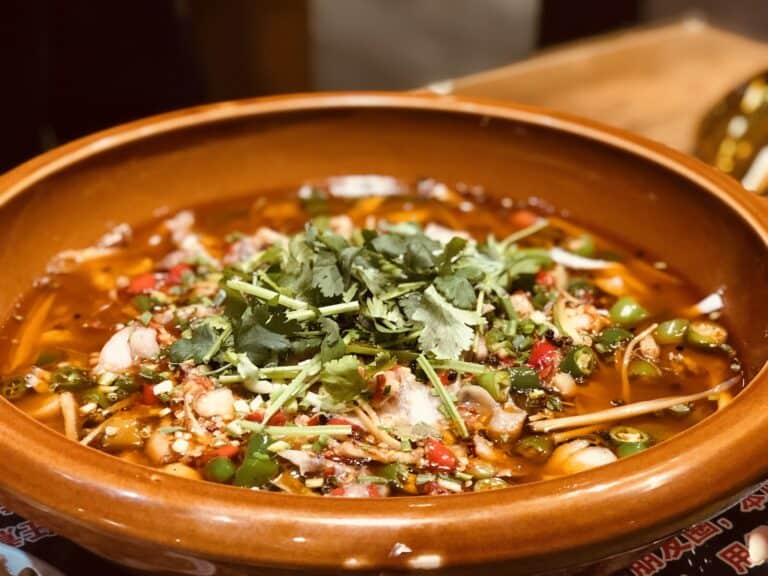Hot and sour soup is a delicious and popular dish in Chinese cuisine, which has been around for centuries. Its unique combination of flavors has made it a favorite among food lovers all over the world. In this blog post, we will explore what is hot and sour soup, its variations, health benefits, and how to make this delicious dish at home. So, let’s dive into the world of this flavorful soup and learn more about it.
What is Hot and Sour Soup?
Hot and sour soup is a traditional Chinese soup known for its perfect balance of spicy, sour, and savory flavors. The soup has a thick texture and a dark, rich color that is achieved by combining various ingredients such as soy sauce, rice vinegar, and chili sauce. The main ingredients of hot and sour soup include a protein source (usually pork or tofu), vegetables (most commonly mushrooms and bamboo shoots), broth, and a blend of seasonings that give the soup its distinctive taste.
Main Ingredients
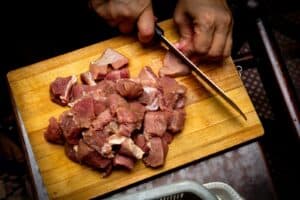
1. Protein: The most common protein used in hot and sour soup is thinly sliced pork, but other options like chicken, shrimp, or tofu can also be used, making it suitable for vegetarians and vegans.
2. Vegetables: The key vegetables used in hot and sour soup are bamboo shoots, shiitake mushrooms, and wood ear mushrooms. These vegetables not only provide texture but also enhance the overall flavor of the soup. Other vegetables, like baby corn and green chillies, can also be added for a more complex flavor profile.
3. Broth: The base of the hot and sour soup is usually made from chicken or vegetable stock. The stock is seasoned with soy sauce, rice vinegar, chili sauce or chili garlic sauce, sesame oil, and white pepper, which gives the soup its hot and sour flavor.
4. Seasonings: The main seasonings used in hot and sour soup are soy sauce, rice vinegar, chili sauce, and white pepper. These flavors are responsible for the distinctive taste of the soup. Additional seasonings like sugar, ginger, and green onions can also be added to enhance the overall flavor.
Variations of Hot and Sour Soup
Hot and sour soup has many variations, depending on regional differences and personal preferences. Some of the major regional variations include:
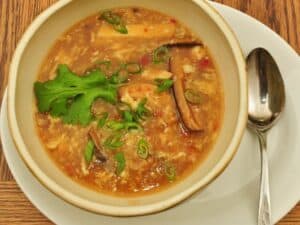
1. Sichuan: In Sichuan province, the soup has a stronger, spicier flavor due to the use of Sichuan peppercorns and chili oil. It also includes tofu and sometimes ground pork.
2. Hunan: The Hunan version of hot and sour soup features a more sour taste with the use of pickled vegetables and extra vinegar.
3. Cantonese: The Cantonese-style hot and sour soup is milder and sweeter, typically containing seafood and a variety of vegetables, with the addition of oyster sauce and sometimes pineapple for extra sweetness.
For those who prefer vegetarian or vegan options, the soup can be made using vegetable stock and substituting tofu or other plant-based proteins for meat. Additionally, ingredients like soy sauce and rice vinegar can be replaced with coconut aminos and apple cider vinegar for a gluten-free version of the soup.
Health Benefits of Hot and Sour Soup
Hot and sour soup not only tastes delicious but also offers several health benefits:
1. Nutritional Value: The soup is packed with protein, fiber, vitamins, and minerals from its various ingredients, making it a nutritious meal option.
2. Immune System Support: The combination of ingredients like ginger, garlic, and chili peppers in the soup can help boost your immune system and fight off colds and flu.
3. Digestive Aid: The spicy and sour flavors of the soup can help stimulate digestion, making it a great appetizer or a soothing meal when you’re feeling under the weather.
4. Weight Loss and Management: Hot and sour soup is low in calories and fat, making it an excellent option for those trying to lose weight or maintain a healthy weight.
To make hot and sour soup even healthier, you can use low-sodium soy sauce, vegetable stock instead of chicken stock, and avoid adding too much oil when cooking the soup.
How to Make Hot and Sour Soup
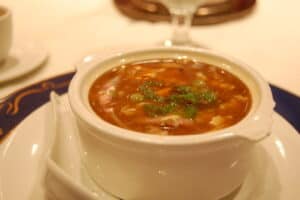
Making hot and sour soup at home is easier than you might think. Here is a step-by-step guide to help you create this delicious dish:
1. Preparation of ingredients: Thinly slice your protein and vegetables. Rehydrate dried shiitake mushrooms in hot water for about 20 minutes, then drain and slice them. If using dried wood ear mushrooms, rehydrate as well and cut off any tough ends. Drain and rinse canned bamboo shoots.
2. Cooking process: In a large pot or wok, heat some oil over medium-high heat and stir-fry your protein and vegetables for a few minutes. Then, add the broth and seasonings, bringing the soup to a boil. Lower the heat and let the soup simmer for a few more minutes to allow the flavors to meld together.
3. Thickening the soup: In a small bowl, mix cornstarch or potato starch with some cold water to create a slurry. Slowly pour the slurry into the soup while stirring continuously to thicken the soup to your desired consistency.
4. Finishing touches: If you’d like to add egg ribbons to your soup, whisk an egg white (or whole egg, depending on your preference) in a small bowl. Slowly pour the egg into the soup while stirring continuously to create delicate egg ribbons. Adjust seasonings to taste.
5. Serving suggestions: Serve hot and sour soup garnished with finely chopped green onions and a drizzle of toasted sesame oil. Enjoy it as a standalone meal or pair it with other Chinese dishes like spring rolls, fried rice, or stir-fry.
Pairing Hot and Sour Soup with Other Dishes
Hot and sour soup pairs well with a variety of dishes from traditional Chinese cuisine to fusion dishes:
1. Traditional Chinese dishes: Serve hot and sour soup alongside dishes like Kung Pao Chicken, Beef and Broccoli, or Fried Rice for a complete meal.
2. Fusion cuisine: Pair hot and sour soup with dishes like Thai Green Curry, Vietnamese Pho, or Korean Bibimbap for an Asian-inspired meal that will tantalize your taste buds.
3. Drinks and beverages: Enjoy your hot and sour soup with a light, crisp beer, a glass of white wine, or a refreshing iced tea to help balance the soup’s bold flavors.
Sour Soup Recipe
Ingredients:

-1 tablespoon vegetable oil
-2 cloves garlic, minced
-1 teaspoon freshly grated ginger
-8 ounces boneless, skinless chicken thighs (or other protein of choice)
-4 cups chicken stock or vegetable stock
-2 tablespoons low sodium soy sauce (or tamari for gluten free)
-1 teaspoon white sugar
-2 tablespoons rice vinegar (or distilled white vinegar)
-2 teaspoons chili paste (or sriracha)
-4 ounces rehydrated shiitake mushrooms, sliced
-4 ounces rehydrated wood ear mushrooms, tough ends cut off and thinly sliced
-1 can (8 ounces) bamboo shoots, drained and rinsed
-2 tablespoons cornstarch or potato starch
-1 egg white (or 1 whole egg)
Instructions:
1. Heat the oil in a large pot or wok over medium-high heat. Add the garlic and ginger and stir-fry for about 30 seconds.
2. Add the chicken and stir-fry until it is lightly browned, about 3 minutes.
3. Pour in the stock, soy sauce, sugar, vinegar, and chili paste. Bring to a boil then let simmer for 10 minutes.
4. Add mushrooms and bamboo shoots. Simmer for an additional 5 minutes.
5. In a small bowl, mix cornstarch or potato starch with some cold water to create a slurry and slowly pour into the soup while stirring continuously to thicken the soup to your desired consistency.
6. If you’d like to add egg ribbons, whisk an egg white (or whole egg, depending on your preference) in a small bowl. Slowly pour into the soup while stirring continuously to create delicate egg ribbons. Adjust seasonings if needed.
7. Serve hot and sour soup garnished with finely chopped green onions and a drizzle of toasted sesame oil. Enjoy it as a standalone meal or pair it with other Chinese dishes like spring rolls, fried rice, or stir-fry. Enjoy!
Note: This soup can also be made vegetarian by replacing the chicken stock with vegetable stock and omitting the meat. For added flavor and texture, add extra vegetables like carrots, bell peppers, and snow peas.
Exploring Southeast Asian Influences
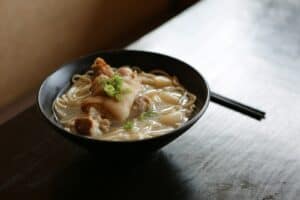
Chinese soups have a rich history influenced by various regions, and one notable influence comes from Southeast Asia. In countries like Thailand and Vietnam, the concept of hot and sour soup takes on its own unique twist, with flavors that reflect the vibrant culinary cultures of these nations. These Southeast Asian sour soups often feature a tantalizing blend of herbs, spices, and exotic ingredients that set them apart from their Chinese counterparts. While Chinese hot pots are famous for their communal dining experience, Southeast Asian sour soups are a solo culinary adventure, offering a piece of Southeast Asian cuisine that is sour, spicy, and simply unforgettable.
Nagi’s Mushroom Magic
When it comes to Chinese soups, mushrooms play a pivotal role in enhancing flavor and texture. The renowned chef Nagi has mastered the art of incorporating mushrooms into Chinese soups, elevating them to a new level of umami-rich goodness. Her creative use of various mushroom varieties like shiitake, wood ear, and more adds depth and complexity to the soup. Instead of the traditional sour soup recipe, Nagi’s creations infuse the umami-rich flavors of mushrooms, enhancing the overall soup experience. Her secret often lies in a unique blend of cornflour and carefully selected mushroom pieces, delivering a savory punch that’s impossible to skip.
Broth Building Blocks
In Chinese cuisine, the broth is considered the heart and soul of a good soup. It’s the foundation upon which the entire flavor profile is built. While we’ve discussed the role of soy sauce, rice vinegar, and chili sauce in creating the signature sour soup flavor, it’s important to delve deeper into the construction of the broth itself.
Typically simmered from quality chicken or vegetable stock, the broth is then meticulously seasoned with a blend of herbs and spices. The addition of a cornflour slurry thickens the soup, giving it that sought-after texture. This vital piece of information reveals that the key to a great Chinese sour soup lies in the careful balance of these broth-building blocks.
The Allure of Hot Pot Variations
Hot pot, a beloved culinary tradition in various Asian cultures, shares some similarities with hot and sour soup but stands out as a distinct experience. While hot and sour soup tantalizes the taste buds with its spicy and sour notes, hot pot invites diners on a communal journey of cooking raw ingredients in a simmering, aromatic broth at the table. It’s a social feast where friends and family gather to add an assortment of ingredients—thinly sliced meats, vibrant vegetables, and mushrooms—creating a flavorful and interactive dining adventure.
The fragrance of the simmering broth, intensified by the addition of dried mushrooms, adds an extra layer of depth to the overall experience. For those who enjoy the communal aspect of dining and the joy of experimenting with flavors, hot pot is a delightful alternative to the individual enjoyment of hot and sour soup.
Elevating Chicken in Hot and Sour Soup
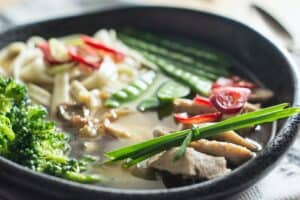
Chicken, a versatile protein, takes center stage in many hot and sour soup recipes, offering a delightful alternative to the more traditional pork or tofu options. The key lies in the preparation; thinly slicing the chicken ensures it cooks quickly, absorbing the rich flavors of the broth. To enhance the taste further, consider marinating the chicken slices in a mixture of soy sauce, ginger, and garlic before adding them to the simmering pot. This simple yet effective step adds a savory depth that elevates the overall taste of the soup.
Moreover, using quality chicken stock as the base provides a robust foundation for the flavors to meld. The addition of mushrooms, whether fresh or rehydrated, complements the chicken, creating a harmonious blend that contributes to the soup’s umami-rich profile. For those seeking a heartier version of hot and sour soup, the marriage of succulent chicken slices and earthy mushrooms is a recipe for culinary success.
Crafting the Perfect Cornstarch Slurry
In the realm of hot and sour soup, the importance of a well-executed cornstarch slurry cannot be overstated. This simple mixture plays a crucial role in thickening the soup to achieve the desired consistency. To master this technique, dissolve cornstarch in cold water, ensuring a smooth and lump-free slurry. When ready, slowly pour this mixture into the simmering soup while stirring continuously. This gradual incorporation prevents clumps and ensures an even thickening of the broth.
The result is a velvety, slightly thickened soup that coats each ingredient with a luscious layer of flavor. Beyond its thickening prowess, the cornstarch slurry serves as a binding agent, marrying the diverse elements of the soup into a harmonious whole. So, the next time you embark on a hot and sour soup adventure, pay special attention to the art of crafting the perfect cornstarch slurry for a truly satisfying culinary experience.
The Art of Tofu Transformation
In the realm of hot and sour soup, tofu emerges as a versatile protagonist, offering a plant-based alternative to meat proteins. The beauty of tofu lies in its ability to absorb the rich flavors of the broth, creating a delightful contrast to the spicy and sour notes. To maximize tofu’s taste-absorbing potential, it’s essential to cut it into small cubes or thin slices. This allows the tofu to soak up the savory essence of the soup, ensuring each bite is a burst of flavor.
Additionally, for those who crave a firmer texture, consider pressing the tofu before adding it to the simmering pot. This simple step removes excess water, allowing the tofu to achieve a meatier consistency and a more satisfying mouthfeel. So, whether you’re a vegetarian or simply seeking a change of pace, the artful incorporation of tofu in hot and sour soup adds a unique layer of taste and texture to this beloved dish.
Unlocking the Mystique of Dried Mushrooms
Dried mushrooms, with their concentrated flavors and robust textures, contribute a layer of mystique to hot and sour soup that fresh counterparts can’t quite match. Rehydrating these culinary gems before adding them to the pot is a crucial step in unlocking their full potential. Begin by soaking dried shiitake or wood ear mushrooms in hot water, allowing them to absorb moisture and regain their plump, tender state.
The resulting liquid from this process is not to be discarded—it’s a treasure trove of umami. Incorporating this mushroom-infused water into the broth enhances the depth of flavor, elevating the entire soup experience. The unique chewiness and earthy notes of rehydrated mushrooms add a satisfying bite, making each spoonful a journey through a forest of rich, savory goodness.
Final Thoughts
Hot and sour soup is a delicious and versatile dish that can be easily adapted to suit your taste preferences and dietary needs. Its unique combination of flavors and health benefits make it a favorite Asian soup for many. Try making hot and sour soup at home using the recipe and tips provided in this blog post, and don’t be afraid to experiment with different ingredients and seasonings. We hope you enjoy exploring the world of hot and sour soup, and we invite you to share your experiences and recipes with us in the comments below. Happy cooking!
Other suggested articles:
- What Are Fermented Foods
- What Are Healthy Living Habits
- What Are The Benefits Of Eating Raw Vegetables
- What Are The Benefits Of High Fiber Vegetables
- What Are The Ingredients In Green Tea
- What Do Green Vegetables Do For Your Body
- What Does Green Tea Taste Like
- What Is A Gazpacho
- What Is Black Sapote
- What Is Healthy Living Index
- What Is Hot And Sour Soup
- What Is Minestrone
- What Is Sugar In Food
- What Should Lunch Consist Of
- What Vegetables Help You Sleep At Night
- Vegetarian Soup With Tofu
- Vegetarian Thanksgiving

